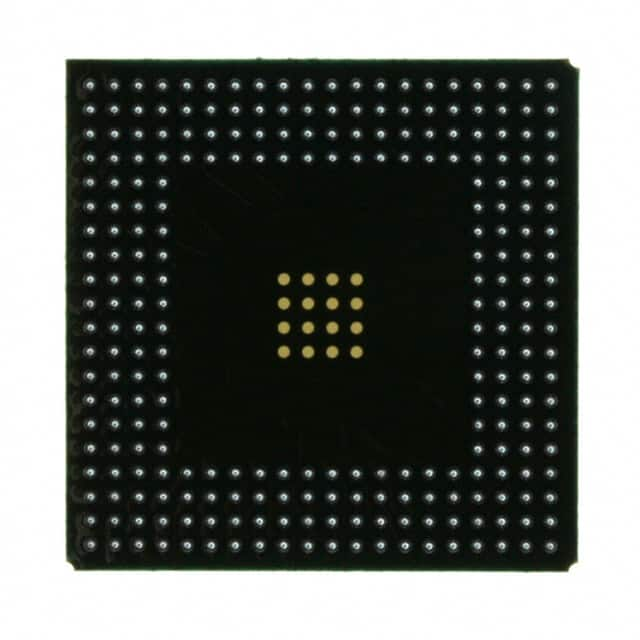XCS30XL-4BG256C
Product Overview
Category
XCS30XL-4BG256C belongs to the category of programmable logic devices (PLDs).
Use
This product is primarily used in digital circuit design and implementation. It provides a flexible and customizable solution for various applications.
Characteristics
- Programmable: XCS30XL-4BG256C can be programmed to perform specific functions based on user requirements.
- High-density: It offers a high number of logic elements, allowing for complex designs.
- Versatile: The device supports a wide range of applications due to its programmability.
- Low power consumption: XCS30XL-4BG256C is designed to operate efficiently with minimal power consumption.
Package
The XCS30XL-4BG256C comes in a 256-ball grid array (BGA) package.
Essence
The essence of XCS30XL-4BG256C lies in its ability to provide a reconfigurable hardware platform that enables users to implement custom digital circuits.
Packaging/Quantity
This product is typically packaged individually and is available in various quantities depending on customer requirements.
Specifications
- Logic Elements: XCS30XL-4BG256C offers 30,000 logic cells.
- I/O Pins: It provides 256 input/output pins for interfacing with external devices.
- Memory: The device includes 1,536 kilobits of embedded RAM.
- Speed: XCS30XL-4BG256C operates at a maximum frequency of 200 MHz.
- Voltage Range: It supports a voltage range of 1.5V to 3.3V.
Detailed Pin Configuration
The pin configuration of XCS30XL-4BG256C is as follows:
- Pin 1: VCCIO
- Pin 2: GND
- Pin 3: TCK
- Pin 4: TMS
- Pin 5: TDI
- Pin 6: TDO
- ...
- Pin 256: VCCIO
Functional Features
- Reconfigurability: XCS30XL-4BG256C can be reprogrammed multiple times, allowing for design changes and updates.
- High-Speed Operation: The device offers fast processing capabilities, making it suitable for time-critical applications.
- Embedded Memory: XCS30XL-4BG256C includes embedded RAM, eliminating the need for external memory components in many designs.
- I/O Flexibility: With 256 I/O pins, the device provides ample flexibility for interfacing with other devices.
Advantages and Disadvantages
Advantages
- Flexibility: XCS30XL-4BG256C allows for custom logic implementation, providing a versatile solution for various applications.
- Cost-effective: The programmable nature of this device eliminates the need for multiple fixed-function chips, reducing overall costs.
- Time-saving: Design iterations can be quickly implemented by reprogramming the device, saving development time.
Disadvantages
- Complexity: Programming and configuring XCS30XL-4BG256C requires expertise in digital circuit design and programming languages.
- Limited Performance: While suitable for many applications, this device may not offer the same performance as dedicated application-specific integrated circuits (ASICs).
Working Principles
XCS30XL-4BG256C operates based on the principles of field-programmable gate arrays (FPGAs). It consists of configurable logic blocks (CLBs), interconnect resources, and embedded memory. The CLBs can be programmed to implement specific logic functions, while the interconnect resources allow for routing signals between different blocks. The embedded memory provides additional storage for data processing.
Detailed Application Field Plans
XCS30XL-4BG256C finds applications in various fields, including:
- Communications: It can be used in networking equipment, such as routers and switches, to implement custom protocols and data processing.
- Industrial Automation: XCS30XL-4BG256C enables the design of control systems for industrial machinery, offering flexibility and adaptability.
- Automotive Electronics: The device can be utilized in automotive applications, such as engine control units (ECUs) and advanced driver-assistance systems (ADAS).
- Consumer Electronics: XCS30XL-4BG256C can be integrated into consumer electronic devices, providing customized functionality and improved performance.
Detailed and Complete Alternative Models
- XCS40XL-4BG256C: Similar to XCS30XL-4BG256C but offers higher logic capacity with 40,000 logic cells.
- XCS20XL-4BG256C: A lower-capacity alternative with 20,000 logic cells, suitable for less complex designs.
- XCS50XL-4BG256C: Provides a higher I/O count with 500 input/output pins, allowing for more
10个与XCS30XL-4BG256C在技术解决方案中的应用相关的常见问题及解答
Sure! Here are 10 common questions and answers related to the application of XCS30XL-4BG256C in technical solutions:
Q: What is the XCS30XL-4BG256C FPGA used for? A: The XCS30XL-4BG256C FPGA is commonly used for implementing digital logic circuits in various technical solutions.
Q: What is the maximum number of logic cells available in the XCS30XL-4BG256C? A: The XCS30XL-4BG256C FPGA has a maximum of 30,000 logic cells.
Q: Can the XCS30XL-4BG256C be reprogrammed? A: Yes, the XCS30XL-4BG256C FPGA can be reprogrammed multiple times to implement different designs.
Q: What is the operating voltage range for the XCS30XL-4BG256C? A: The XCS30XL-4BG256C operates at a voltage range of 1.5V to 3.3V.
Q: Does the XCS30XL-4BG256C support high-speed interfaces like PCIe or Ethernet? A: Yes, the XCS30XL-4BG256C supports high-speed interfaces like PCIe and Ethernet through dedicated transceivers.
Q: Can I use the XCS30XL-4BG256C for video processing applications? A: Yes, the XCS30XL-4BG256C can be used for video processing applications by leveraging its programmable logic and high-speed interfaces.
Q: What development tools are available for programming the XCS30XL-4BG256C? A: Xilinx provides Vivado Design Suite, which includes tools for designing, simulating, and programming the XCS30XL-4BG256C.
Q: Is the XCS30XL-4BG256C suitable for low-power applications? A: The XCS30XL-4BG256C is not specifically designed for low-power applications, but power optimization techniques can be applied to reduce power consumption.
Q: Can I interface the XCS30XL-4BG256C with external memory devices? A: Yes, the XCS30XL-4BG256C has dedicated memory interfaces that allow it to interface with external memory devices like DDR3 or DDR4.
Q: What are some typical applications of the XCS30XL-4BG256C? A: The XCS30XL-4BG256C is commonly used in applications such as telecommunications, industrial automation, medical devices, and aerospace systems.
Please note that the answers provided here are general and may vary depending on specific design requirements and implementation details.


